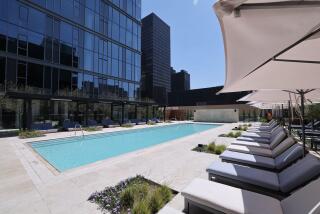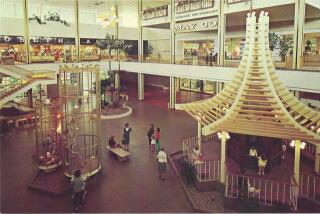Warm, Snowless World : Life Bustles Below Streets of Toronto
- Share via
TORONTO — It is a typical Canadian winter day: snow and sleet, below-freezing temperatures and spirit-sapping winds--altogether miserable, if you happen to be outside. But for thousands of people, this is no problem. The weather is hardly a factor in their lives.
For if you work or shop in downtown Toronto, you can go through a normal 8-to-5 day and never feel the snap of the cold against your face, never have to wade through snow and slush.
Increasingly, people in this city of nearly 3 million work, shop and play underground. And while other Canadian cities also have their underground complexes, more Toronto residents virtually live underground than in any other metropolis, if the city’s boosters can be believed.
Three Miles of Passages
As things stand--and with a building boom regaining momentum, nothing stands here for very long--there are about three miles of underground passages in Toronto connecting nearly all the major downtown office buildings and department stores, plus dozens of side passages. Together, they form what city planners call “The Mall.”
It is not a mall in the dictionary sense, not a shaded walk or promenade. It consists of tunnels lined with shops, small businesses and banks--lots of banks. Further, it connects via Toronto’s extensive subway system with several other, smaller underground complexes, and this gives the city a truly subterranean feel.
If you live near a subway stop or keep your car in an attached garage and park indoors at work, it is possible to spend virtually the entire winter without ever being really outdoors.
Fetid Air, Claustrophobia
For people faced with car-covering snowdrifts and bone-numbing cold, the prospect of spending winter in short sleeves and street shoes may seem pleasant. Yet, not all is well for those who experience the season largely through the horror stories of those unfortunates who are forced into an occasional brush with nature.
Although the mazelike mall is air-conditioned, there is an impression of fetid air, and the indirect lighting that replaces all natural illumination combines with low ceilings to create a sense of being closed in that can turn minor claustrophobia into near-panic.
The tunnels are filled with people--some say more than 200,000 on any given weekday--but despite the crowds, there is little noise except for the inescapable and forgettable piped-in music.
What can be heard is the muffled sound of shuffling--constant shuffling--as expressionless and largely mute men and women move past restaurants, bookstores, magazine kiosks, clothing shops and the flashing lights of the bank offices.
Even during the Christmas season, the sound of shuffling was dominant, and the occasional clang of a Salvation Army bell or the voices of choral groups singing carols seemed almost alien intrusions, unwelcome reminders of an unpleasant world 20 feet overhead.
Apart from the complaints about stale air and claustrophobia, it is this alienation from the outside that seems to bother many who spend their time in the mall.
“You know,” a bookstore employee said, “I don’t like it here very much. There is no air, no breeze, no sun. Hell, I have only your word that it’s cold up there.”
Underground, you can get groceries, a loan or a massage.
Roberta Evans, an usher in an underground theater, said she has worked below the surface for three years.
“It’s eerie,” she said. “I feel like a rat in a laboratory experiment, being run through a maze. I still don’t know where I am much of the time.”
Comprehensible maps of the underground arteries are rare. Directional signs are in many cases confusing, and finding a restroom can be a problem.
“After hours of having people ask me where the washrooms are or how to get to some store, I want to kill,” said George Pooles, a clothing salesman.
If you can find your way, though, you can get almost anything you want in one tunnel or another. Without ever going outside, you can sleep, eat, have a tooth filled, get a massage, take out a loan, play a game of squash, buy clothing of every kind, have it cleaned, do your grocery shopping, have your psyche analyzed, attend a play. About all that is missing is a hospital.
With all this, the mall and its underground life has supporters, of course. Besides the obvious advantanges of staying dry and warm in the winter and cool in the summer, the mall is safe. There are security people everywhere; no serious crime has been reported since the first stage of the complex opened in 1967.
And it is clean. Almost as numerous as the private police are people with brooms, buckets, mops and plastic bags keeping the area spotless.
It is a necessary job. There are at least 1,000 shops, and more open for business every month. In the office buildings above, more than 175,000 workers go about their tasks. They take their breaks in the mall, eat their meals and do their shopping there.
Aside from the urge to get out of the weather, the underground complex was developed to solve the problems that arose from the rejuvenation of downtown Toronto in the 1960s and 1970s.
So many high-rise buildings were going up that the streets and sidewalks were overwhelmed by traffic--auto and pedestrian. People were forced off the sidewalks and into the streets.
There was not enough room for the shops and stores needed to accommodate all the new workers brought into the downtown area. Zoning regulations required that new projects include underground facilities, and public funding was provided to finance the connecting tunnels.
It worked. Even in good weather, the sidewalks of downtown Toronto resemble a city on a downward slide, not the fast-growing area that it really is. And the burrows below are full of people shuffling along in such numbers that it takes a real effort to stand still and window-shop.
In fact, the underground development may have worked too well. Fearing that the downtown area is becoming “a city of moles,” government officials are restricting the growth of the underground mall and requiring building developers to provide ground-level stores and shops.
Planning Commissioner Stephen McLaughlin told reporters last year that the weatherproof complex threatens the individuality of the city.
“When you’re down there,” he said, “do you know you’re in Toronto? Isn’t an underground shopping center the same everywhere . . . ? I’m not necessarily opposed to underground networks, but something has to be done to give them an identity, a city feel. People should feel they’re still walking the streets.”
Architect A.J. Diamond has said that the malls can draw the life out of a city.
“People become disoriented,” he said. “There’s no sense of community.”
More to Read
Sign up for The Wild
We’ll help you find the best places to hike, bike and run, as well as the perfect silent spots for meditation and yoga.
You may occasionally receive promotional content from the Los Angeles Times.






